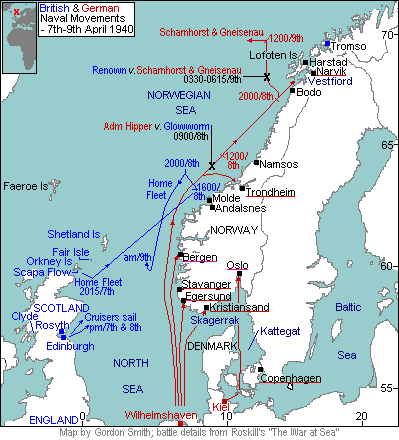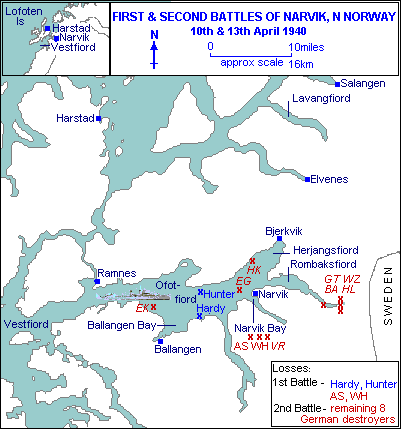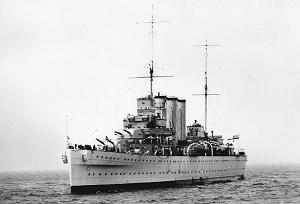Invasion
of Norway

...1940
APRIL
1940
ATLANTIC
- APRIL 1940
German Raiders - “Orion”
sailed for the Pacific and Indian Oceans around
South America's Cape Horn. She was out for 16
months before returning to France.
10th - “U-50” on
patrol off the Shetlands in support of the
Norwegian invasion, was sunk by destroyer “Hero”.
Faeroe Islands -
On the 13th April, following the German invasion
of Norway, an advance guard of Royal Marines
landed on the Faeroe Islands, northwest of the
Shetland Islands with the eventual agreement of
the Danish Governor.
Monthly Loss Summary: 4
British, Allied and neutral ships of 25,000 tons
from all causes; 1 German U-boat.
EUROPE
- APRIL 1940
Atomic Bomb -
Just as the “phoney war” ended in Europe (it never
existed at sea) the end of the war was
foreshadowed when the British government
established the Maud Committee to oversee nuclear
research. Similar steps had already been taken in
the United States, all of which eventually led to
an operational atomic bomb.
German Codes -
The Bletchley Park Ultra programme was now
decoding some Luftwaffe low-level Enigma codes,
partly because of poor German security procedures.
There is little evidence the hard-won information
influenced the war over the next two violent
months.
|
Norwegian
Invasion & Campaign
(see
map above)
3rd -
The first German troop transports sailed
for Norway. 7th - German
covering and troop-carrying warships
headed for Norway.
8th - Operation 'Wilfred': Royal
Navy destroyers laid minefields,
simulated and real at three points off
the Norwegian coast, including near
Bodo. Battlecruiser
Renown
and other destroyers provided cover. One
of the screen,
GLOWWORM
(Lt-Cdr Roope) was detached to search
for a man overboard just as 8in-gunned
cruiser “Admiral Hipper” headed into
Trondheim. They met to the northwest of
the port and the destroyer was soon
sunk, but not before she rammed and
damaged “Hipper”. + Lt-Cdr Gerard Roope
RN was posthumously awarded the Victoria
Cross.
7th-8th
- In response to reported German
movements, units of the Home Fleet
including Rodney,
Valiant,
Repulse,
four cruisers and 14 destroyers sailed
from Scapa Flow and Rosyth. Accompanying
them was a French cruiser and two
destroyers. Two more British cruisers
and nine destroyers left other duties
and headed for Norwegian waters. Next
day, on the 8th, they were joined by the
four troop-carrying cruisers of
Operation 'R4', but after the
soldiers had been disembarked back in
Britain. More than 20 submarines,
including three French and one Polish
took up positions.
9th,
Germany invaded Denmark and Norway
(Operation 'Weserubung'):
Copenhagen was soon occupied and DENMARK
surrendered. In Norway, seaborne troops
landed at Oslo, Kristiansand, Egersund
and Bergen in the south, Trondheim in
the centre and Narvik in the north. The
southern forces and those from Trondheim
pushed inland and joined up by the end
of the month. They then moved north to
relieve Narvik, which was isolated by
the Allies soon after the first German
landings. German Navy forces included a
pocket battleship, six cruisers, 14
destroyers, torpedo boats and
minesweepers for the landings at the six
Norwegian ports, with battlecruisers
“Scharnhorst” and “Gneisenau” covering
the two most northerly landings. Thirty
U-boats patrolled off Norway and British
bases, but throughout the campaign
suffered from major torpedo defects.
Early in the morning of the 9th,
battlecruiser Renown
was in action with the two German
battlecruisers to the west of Vestfiord.
“Gneisenau” was damaged and “Renown”
slightly. The Germans withdrew. As
“Renown” was in action, German
occupation forces heading for Oslo came
under heavy fire from Norwegian coastal
defences. Shore-sited guns and torpedoes
in Oslo Fiord sank heavy cruiser
“BLUCHER”. A Home Fleet cruiser force
was detached to attack the German
warships in Bergen, but ordered to
withdraw. They came under continuous air
attack and destroyer
GURKHA
was bombed and sunk southwest of Bergen.
That evening, German cruiser “KARLSRUHE”
left Kristiansand and was torpedoed by
submarine “Truant”. She was scuttled
next day.

10th,
First Battle of Narvik - The 2nd
Destroyer Flotilla (Capt. Warburton-Lee)
with “Hardy”, “Havock”, “Hostile”,
“Hotspur” and “Hunter”, entered
Ofotfiord to attack the German ships
assigned to the occupation of Narvik.
These included 10 large destroyers.
Several transports were sunk together
with destroyers “ANTON SCHMITT” (AS)
and “WILHELM HEIDKAMP” (WH)
in Narvik Bay.
Other German destroyers were damaged,
but as the British 2nd Flotilla retired,
HARDY
was beached,
HUNTER
sunk by the remaining German ships and
“Hotspur” badly damaged. + Capt Bernard
Warburton-Lee RN was posthumously
awarded the
Victoria Cross.
By the 10th,
the British Home Fleet was reinforced by
battleship
Warspite
and carrier Furious.
On the same day submarine
THISTLE
on patrol off Utsira failed in an attack
on “U-4”. Shortly after she was sunk by
the same U-boat. Fleet Air Arm Skua
dive-bomber’s of 800 and 803 Squadrons
flying from the Orkney Islands sank
German cruiser "KOENIGSBERG" at her
moorings in Bergen, the first major
warship sunk by air attack. She was
damaged earlier by shore batteries in
the landings. .
11th -
Returning from the Oslo landings, German
pocket battleship “Lutzow” was torpedoed
and badly damaged by submarine
“Spearfish” in the Skagerrak. Cruiser
“Penelope” on her way into Narvik was
damaged running aground in Vestfiord.
13th,
Second Battle of Narvik - Battleship
Warspite
and nine destroyers were sent into the
Narvik fiords to finish off the
remaining German ships. Submarine “U-64”
was surprised and sunk by “Warspite's”
Swordfish catapult aircraft as it
scouted ahead. The eight surviving
German destroyers – “BERND VON ARNIM” (BA),
“DIETHER VON ROEDER”
(DR), “ERICH GIESE” (EG),
“ERICH KOELNNER”
(EK), “GEORG THIELE” (GT),
“HANS LUDEMANN”
(HL), “HERMANN KUNNE” (HK) and
“WOLFGANG ZENKER” (WZ) were
all destroyed or scuttled. The British
“Eskimo” and “Cossack” were damaged. By
the 13th, the first British troop
convoys had left the Scottish Clyde for
Narvik, but some ships were diverted to
Namsos. German forces were
well-established in the south and centre
of Norway and had control of the air.
14th -
Submarine
TARPON
on patrol off southern Norway was sunk
by German minesweeper “M-6”. German
gunnery training ship “BRUMMER” was
torpedoed and sunk by submarine
“Sterlet” .
14th-16th
- The first Allied landings took place
between the 14th and 16th. In the north,
British troops occupied Harstad in
preparation for an attack on Narvik.
They were reinforced by French and
Polish units through into May. Royal
Marines led British and French troops
into Namsos ready for an attack south
towards Trondheim. The British went
ashore in the Andalsnes area to try to
hold central Norway with the Norwegian
Army. Neither of these operations proved
possible and on the 27th April the
decision was taken to pull out of
central Norway.
15th -
As the Harstad-bound troopships
approached their destination, escorting
destroyers “Brazen” and “Fearless”
located and sank “U-49”. Southwest of
Stavanger, “U-1” went to the bottom
after striking a mine.
 17th
- Heavy cruiser
Suffolk (right - NavyPhotos) bombarded
installations at Stavanger, but on her
return was badly damaged by Ju-88
bombers and barely made Scapa Flow with
her stern awash. 17th
- Heavy cruiser
Suffolk (right - NavyPhotos) bombarded
installations at Stavanger, but on her
return was badly damaged by Ju-88
bombers and barely made Scapa Flow with
her stern awash.
18th -
Four days after sinking the “Brummer”,
submarine
STERLET
was presumed sunk in the Skagerrak by
German anti-submarine trawlers.
24th -
After four days continuous AA duty off
Andalsnes, cruiser
Curacoa
was badly damaged by bombs. Carrier
Glorious
flew off obsolescent Gladiator biplanes
for shore operations.
27th -
Allied plans to attack towards Trondheim
and hold central Norway proved
impossible. The decision was taken to
pull out of central Norway, and the
evacuation of Andalsnes and Namsos got
under way.
30th -
Sloop “BITTERN” was sunk by Ju-87
dive-bombers off Namsos.
|
29th -
Submarine
UNITY
was lost in collision with a Norwegian merchantman
off the northeast coast of England.
Air War - The
first mines were laid by RAF Bomber Command off
the German and Danish coasts.
Monthly Loss Summary:
54 British, Allied and neutral ships of 134,000
tons from all causes.
MAY 1940
ATLANTIC
- MAY 1940
German Raiders -
“Widder” headed for central Atlantic operations
before returning to France six months later. On
her way into the Indian Ocean, “Atlantis” laid
mines off South Africa.
Iceland & Dutch
West Indies - On the 10th as Germany
attacked France and the Low Countries, British
Royal Marines landed from two cruisers at
Reykjavik, Iceland then part of the Danish Crown.
More troops followed to set up air and sea bases
that became vital to Britain's defence of the
Atlantic supply routes. To avoid any possibility
of confusion, Winston Churchill always insisted on
differentiating between Iceland (C) and Ireland
(R). Shortly after Germany invaded Holland, Allied
troops landed on the Dutch West lndies islands of
Aruba and Curacoa to protect oil installations.
Battle of the
Atlantic -
U-boats started returning to the Western
Approaches and as they did, one of the first
‘Flower’ class corvettes “Arabis” made a
depth-charge attack in defence of a Gibraltar/UK
convoy. With the closure of the Mediterranean to
Allied shipping, the trade routes around Africa
and the ports en route took on a new importance.
Particularly vital was the West African base at
Freetown, Sierra Leone
Monthly Loss Summary:
10 British, Allied and neutral ships of 55,000
tons from all causes.
EUROPE
- MAY 1940
|
Norwegian Campaign - continued
2nd/3rd
- In three days and nights the last
10,000 British and French troops had
been evacuated from Namsos and around
Andalsnes following the failure to
attack towards Trondheim and hold
central Norway. Other troops were
later landed further north, including
at Bodo in an attempt to block the
German advance from Trondheim towards
Narvik. The Allies continued to build
up forces for the attack on Narvik. +
Lt-Cdr Richard Stannard RNR,
commanding officer of HM trawler Arab
of the 15th Anti-Submarine Striking
Force, was awarded the
Victoria
Cross for gallantry under air
attack during operations off Namsos.
3rd
- Retiring northwest from
Namsos, destroyers
AFRIDI
and the French “BISON” were sunk by
Ju-87 Stuka dive-bombers.
4th
- As preparations continued in
northern Norway for the attack on
Narvik, Polish destroyer “GROM” was
bombed and sunk.
5th
- Submarine
SEAL
successfully laid mines in the
southern Kattegat on the 4th before
being damaged by a German mine. Trying
to make for neutral Sweden on the
surface, she was attacked and captured
off The Skaw by German air and sea
patrols.
17th
- Cruiser
EFFINGHAM
ran aground on an uncharted rock in
Vestfiord carrying troops to Bodo to
help block the German advance on
Narvik. She was later torpedoed and
abandoned.
23rd
- By now carriers
Furious and
Glorious had flown ashore the
first modern RAF fighters.
24th
- The Allies decided to pull out of
Norway altogether, but not before
Narvik had been captured and the port
installations destroyed.
26th
- During the attack on Narvik, AA
cruiser
CURLEW
was bombed and sunk in nearby Lavang
Fjord.
28th
- Two days after the loss of sister
ship “Curlew”,
Cairo
was badly damaged off the town of
Narvik just as French and Polish
troops completed its capture. The
Norwegian Campaign shortly drew to a
close
|
Britain -
Following a 10th May House of Commons debate on
the Norwegian campaign, Prime Minister Neville
Chamberlain resigned and Winston Churchill assumed
leadership. Albert V Alexander succeeded him as
First Lord of the Admiralty. The planned attack on
Narvik was still to go ahead, but that same day
the German Blitzkrieg was launched on Holland,
Belgium and France .
|
Western
Front
10th,
Germany invades Holland, Belgium,
Luxembourg (Operation 'Gelb') -
British and French troops crossed the
border into Belgium and took up
forward positions, but the main German
thrust was a planned encircling
movement further south through the
forests and mountains of the Belgium
Ardennes.
13th
- The Germans entered France at Sedan.
After breaking through, German armour
headed west for the Channel to trap
the Allied armies now in Belgium and
northern France. British Admiralty
plans had already been made to
withdraw shipping from the Low
Countries, block main ports, demolish
installations and remove gold and
diamonds. Most of these duties were
carried out with the aid of Royal Navy
destroyers which suffered heavy losses
over the next few weeks. Still on the
13th, Holland’s Queen Wilhelmina and
her Government were now on their way
to Britain aboard a Royal Navy
destroyer to continue Holland's fight.
14th
- The centre of Rotterdam was
blitzed by the Luftwaffe.
15th -
Destroyers continued to support Allied
land forces off the Dutch and Belgian
coasts. Under heavy air attack, two
were bombed and beached over the next
few days, starting with
VALENTINE
in the Scheldt Estuary. The DUTCH
Army surrendered to the
Germans. On the same day, Winston
Churchill’s War Cabinet, anticipating
the Battle for Britain decided not to
send any more RAF fighters to France.
The strategic bombing of
Germany was also ordered and raids
made on the Ruhr.
17th
- As the Allies retreated from
Belgium, German forces entered
Brussels.
19th
- The second destroyer
supporting Allied land forces,
WHITLEY
was beached near Nieuport on the
Belgian coast with bomb damage.
20th
- German tanks reached the English
Channel near Abbeville, shortly
turning right and advancing north on
the ports of Boulogne, Calais and
Dunkirk. Destroyers carried Allied
troops to Boulogne and Calais and
remained in support. Over the next
four days, five Allied destroyers were
lost and others damaged in the area. 21st
- French destroyer “L’ADROIT” bombed
and sunk off Dunkirk. 23rd
- French destroyer “ORAGE” bombed off
Boulogne and “JAGUAR” torpedoed and
sunk by German E-boats “S-21” and
“S-23” off Dunkirk. 24th
- A fourth French destroyer, “CHACAL”
was bombed off Boulogne. The British
WESSEX
was also bombed and sunk supporting
the defenders of Calais.
26th
- Both Boulogne and Calais fell to the
Germans. The British Expeditionary
Force and French Army fell back on
Dunkirk.
26th
May-4th June, Dunkirk Evacuation
(Operation 'Dynamo') - Initial
plans were to lift off 45,000 men of
the British Expeditionary Force over a
two-day period under the direction of
Vice-Adm B. H. Ramsey. In the next
five days, 8,000 men on the 27th May,
18,000 on the 28th, 47,000 on the
29th, 54,000 on the 30th and 68,000 on
the 31st were carried to Britain - a
total of 195,000, both British and
French. Every phase of the operation
was subject to heavy air, sea and land
attack.
Forty
British, six French and a Polish
destroyer took part, together with 800
other vessels, large and small. Losses
were considerable. The Dunkirk
evacuation continued into June.
28th
- The
BELGIUM Army
surrendered on the northern flank,
seriously endangering the Allied
evacuation from Dunkirk.
29th
- Apart from those damaged, three
Royal Navy destroyers were sunk in the
English Channel off the Dunkirk
beaches on this day -
GRAFTON
torpedoed by submarine “U-62”,
GRENADE
by bombing, and
WAKEFUL
by a torpedo from E-boat “S-30”.
30th
- French destroyers also continued to
suffer losses. “BOURRASQUE” was mined
off the Belgium port of Nieuport and
sunk by shore batteries. 31st -
“Bourrasque’s” sister ship “SIROCCO”
was torpedoed and sunk by German
E-boats “S-23” and “S-26”.
|
31st - German
“U-13” was believed sunk by sloop “Weston” off the
English East Coast fishing port of Lowestoft.
Air War - Minelaying
continued along the south and east coasts of
Britain as well as the waters of Holland, Belgium
and northern France during the German Blitzkrieg.
Monthly Loss Summary:
90 British, Allied and neutral ships of 231,000
tons from all causes.
|
|